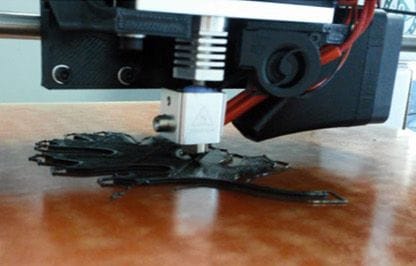![3D printing a lignin-based filament material [Source: ORNL]](https://fabbaloo.com/wp-content/uploads/2020/05/image-asset_img_5eb09f23a0c6d.jpg)
ORNL Researchers have found a way to 3D print lignin.
Lignin is a natural organic polymer that is found in many plants, particularly wood and tree bark. In fact, it makes up around 30% of the weight of all tree-stored carbon in the world, and is the second most frequently found renewable material after cellulose, which has previously been 3D printed.
But could it be 3D printed? If so it might be possible to take advantage of its rigidity and resistance to rot.
There are plenty of challenges in doing so, however, as lignin has a major problem: instead of melting at higher temperatures, it chars. That’s not really compatible with 3D printing, as the viscosity of the lignin simply increases.
However, the researchers discovered in a surprise outcome that by mixing the lignin with a nylon material, they were able to overcome the viscosity issue. They explain:
“However, lignin-modified nylon composites containing 40 to 60 wt % sinapyl alcohol–rich, melt-stable lignin exhibit enhanced stiffness and tensile strength at room temperature, while—unexpectedly—demonstrating a reduced viscosity in the melt.”
![Microscopic view of 3D printed lignin and nylon composite [Source: ORNL]](https://fabbaloo.com/wp-content/uploads/2020/05/image-asset_img_5eb09f240e1cb.jpg)
The researchers further enhanced the new material by adding an amount of carbon fibers to the compound, through which they were able to increase the strength significantly:
“Further, incorporation of 4 to 16 wt % discontinuous carbon fibers enhances mechanical stiffness and printing speed, as the thermal conductivity of the carbon fibers facilitates heat transfer and thinning of the melt.”
This is quite interesting; using an embedded material to assist in the melt process. It’s somewhat reminiscent of Essentium’s electrical filament, FUSE, except without the electricity.
And further:
“We found that the presence of lignin and carbon fibers retards nylon crystallization, leading to low-melting imperfect crystals that allow good printability at lower temperatures without lignin degradation.”
![3D print using lignin and nylon, showing both stiffness and flexibility [Source: ORNL]](https://fabbaloo.com/wp-content/uploads/2020/05/image-asset_img_5eb09f2464f29.jpg)
This is a truly fascinating project, as the researchers seem to have found a way to combine multiple materials that apparently enhance each other’s 3D printing properties. I’m wondering how many other unusual combinations of commonly available materials might provide similar outstanding 3D print performance.
What’s really interesting is the approach used by the researchers, which could certainly be used to identify more composite combinations.
![Overview of how lignin might be used as a renewable 3D print material [Source: ORNL]](https://fabbaloo.com/wp-content/uploads/2020/05/image-asset_img_5eb09f24c0316.jpg)
As for this material itself, this is only a research project and is unlikely to appear on a product shelf for purchase unless a chemical or filament company licenses the formula for commercial use. But if it does, we would then have another way to make use of trillions of tons of renewable lignin worldwide: 3D printing.
Via Science Advances











A research thesis details the incredibly complex world of volumetric 3D printing. We review the highlights.